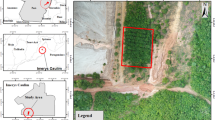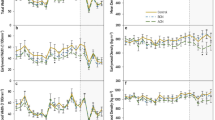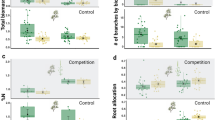Abstract
Cherrybark oak (Quercus pagoda Raf.) stump sprouts were studied for 5 years in a 30-year-old plantation thinned to 70–75% stocking (light thinning) and 45–50% stocking (heavy thinning). Sprouting success, survival, number of sprouts per stump, and sprout height differed little between thinning treatments throughout the 5-year study period. Pre-harvest tree d.b.h. also had no influence on sprout survival and development. A 2-year drought reduced survival and may have influenced sprout development. Sprout clump survival dropped from 90% 1 year following thinning to 46% 3 years after thinning. Although sprout height averaged 337 cm 5 years after thinning, annual sprout growth decreased from 166 cm the first year after thinning to 33 cm in each of the last 2 growing seasons. Results indicated that bottomland hardwood regeneration evaluation models may underestimate the potential of oak stump sprouts to contribute to pre-harvest regeneration assessments. Further study in the role of stump sprouts to regenerate bottomland oak species is needed.



Similar content being viewed by others
References
Baker JB, Broadfoot WM (1979) A practical field method of site evaluation for commercially important southern hardwoods. USDA For Serv Gen Tech Rep SO-26, 51 p
Beck DE (1983) Planned hardwood regeneration. For Farmer 43:18–19
Cobb SW, Miller AE, Zahner R (1985) Recurrent shoot flushes in scarlet oak stump sprouts. For Sci 31:725–730
DeBell DS (1971) Stump sprouting after harvest cutting in swamp tupelo. USDA For Serv Res Pap SE-83, 6 p
Dey DC (1993) Predicting quantity and quality of reproduction in the uplands. pp. 138–145. In: Loftis DL, McGee CE (eds) Oak Regeneration: Serious Problems, Practical Recommendations. USDA For Serv Gen Tech Rep SE-84, 319 p
Dey DC, Ter-Mikaelian M, Johnson PS, Shifley SR (1996) Users guide to ACORn: a comprehensive Ozark regeneration simulator. USDA For Serv Gen Tech Rep NC-180, 35 p
Francis JK (1983) Suckering and root connections of sweetgum on clayey soil. pp 189–192 In: Jones EP, Jr (ed) Proceedings of the Second Biennial Southern Silvicultural Research Conference. USDA For Serv Gen Tech Rep SE-24, 514 p
Gardiner ES, Helmig LM (1997) Development of water oak stump sprouts under a partial overstory. New For 14:55–62
Goelz JCG (1995) A stocking guide for southern bottomland hardwoods. South J Appl For 19:103–104
Golden MS (1999) Factors affecting sprouting success in a bottomland mixed hardwood forest. pp 157–163 In: Haywood JD (ed) Proceedings of the Tenth Biennial Southern Silvicultural Research Conference. USDA For Gen Tech Rep SRS-30, 618 p
Groninger JW, Stein HD, Zedaker SM, Smith DW (1998) Growth response and cost comparisons for precommercial thinning methods of Appalachian oak stump sprout clumps. South J Appl For 22:19–23
Hart CP, Hodges JD, Belli KL, Stanturf JA (1995) Evaluating potential oak and ash regeneration on minor bottoms in the Southeast. pp 434–442. In: Edwards MB (Comp) Proceedings of the Eighth Biennial Southern Silvicultural Research Conference. USDA For Serv Gen Tech Rep SRS-1, 633 p
Helms JA (ed) (1998) The dictionary of forestry. The Society of American Forestry, Bethesda, MD, 210 p
Hodges JD (1987) Cutting mixed bottomland hardwoods for good growth and regeneration. In: Proceedings of the Fifteenth Annual Hardwood Symposium. Hardwood Research Council, Memphis, TN, pp 53–60
Hook DD, LeGrande WP, Langdon OG (1967) Stump sprouts on water tupelo. South Lumber 215(2680):111–112
Hook DD, Kormanik PP and Brown CL (1970) Early development of sweetgum root sprouts in coastal South Carolina. USDA For Serv Res Pap SE-62, 6 p
Johnson PS (1975) Growth and structural development of red oak sprout clumps. For Sci 21:413–418
Johnson PS, Rogers R (1984) Predicting 25th-year diameters of thinned stump sprouts of northern red oak. J For 82:616–619
Johnson PS, Shifley SR and Rogers R. (2002) The ecology and silviculture of oaks. CABI Publishing, Oxon, UK, 503 p
Johnson RL (1961) Hardwood sprouts dominate bottom-land clearing. USDA For Serv South For Exp Stn Occas Pap 186, 1 p
Johnson RL (1980) New ideas about regeneration of hardwoods. In: Proceedings of the Hardwood Committee’s Symposium on Oak Regeneration, Atlanta, GA, pp 17–19
Johnson RL, Deen RT (1993) Prediction of oak regeneration in bottomland forests. pp 146–155. In: Loftis DL, McGee CE (eds) Oak regeneration: Serious Problems, Practial Recommendations. USDA For Gen Tech Rep NC-139, 319 p
Kennedy HE, Jr. (1982) Growth and survival of water tupelo coppice regeneration after six growing seasons. South. J. Appl. For. 6:133–135
Kormanik PP, Brown CL (1967) Root buds and the development of root suckers in sweetgum. For Sci 13:338–345
Lamson NI (1983) Pre-commercial thinning increases diameter growth of Appalachian hardwood stump sprouts. South J Appl For 7:93–97
Lowell KE, Mitchell RJ, Johnson PS, Garrett HE, Cox GS (1987) Predicting growth and “success” of coppice-regenerated oak stems. For Sci 33:740–749
McGee CE (1978) Size and age of tree affect white oak stump sprouting. USDA For Serv Res Note SO-239, 2 p
McQuilkin RA (1975) Growth of four types of white oak reproduction after clearcutting in the Missouri Ozarks. USDA For Serv Res Pap NC-116, 5 p
Meadows JS (1996) Thinning guidelines for southern bottomland hardwood forests. pp 98–101 In: Flynn KM (ed) Proceedings of the Southern Forested Wetlands Ecology and Management Conference. Consort Res South For Wetlands, Clemson University, Clemson, SC, 332 p
Putnam JA, Furnival GM, McKnight JS (1960) Management and inventory of southern hardwoods. USDA For Serv Agric Hdbk No 181, 102 p
Sander IL (1972) Size of oak advance reproduction: key to growth following harvest cutting. USDA For Serv Res Pap NC-79, 6 p
Sander IL, Johnson PS, Watt RF (1976) A guide for evaluating the adequacy of oak advance reproduction. USDA For Serv Gen Tech Rep NC-23, 7 p
SAS (1985) SAS/STAT guide for personal computers, version 6. SAS Institute Inc, Cary, NC, 378 p
Shafer EL Jr. (1965) Deer browsing of hardwoods in the northeast. USDA For Serv Res Pap NE-33, 33 p
Solomon DS, Blum BM (1967) Stump sprouting of four northern hardwoods. USDA For Serv Res Pap NE-59, 13 p
Weigel DR, Johnson PS (1998) Stump sprouting probabilities for southern Indiana oaks. USDA For Serv Tech Brief TB-NC-7, 6 p
Weigel DR, Peng CJ (2002) Predicting stump sprouting and competitive success of five oak species in southern Indiana. Can J For Res 32:703–712
Acknowledgements
We thank the Louisiana Department of Wildlife and Fisheries for their support in installing the cherrybark oak thinning study. Emile Gardiner, Daniel Dey, and Kenny Ribbeck provided constructive comments on an earlier draft of this manuscript.
Author information
Authors and Affiliations
Corresponding author
Additional information
The U.S. Government's right to retain a non-exclusive, royalty-free license in and to any copyright is acknowledged
Rights and permissions
About this article
Cite this article
Lockhart, B.R., Chambers, J.L. Cherrybark oak stump sprout survival and development five years following plantation thinning in the lower Mississippi alluvial valley, USA. New Forests 33, 183–192 (2007). https://doi.org/10.1007/s11056-006-9022-7
Received:
Accepted:
Published:
Issue Date:
DOI: https://doi.org/10.1007/s11056-006-9022-7




